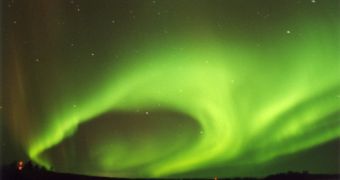Aurora Borealis, most commonly known as the Northern Lights, is created when cosmic rays - solar wind in special - interact with the Earth's magnetic field and the atmosphere in order to determine light emissions in the gas atoms located in the upper layers of the atmosphere. In the middle of the 20th century, Robert Duncan, an Australian researcher, discovered that light emitted by the aurora borealis could be polarized. However these emissions are extremely rare and since no other reports of such a phenomenon have been issued, his findings were discredited.
Now, a team of researchers from the Laboratory of Planetology of Grenoble have proven that, indeed, some amounts of light emitted in the Earth's upper atmosphere can be polarized. The research was conducted by studying auroral light between 2006 and 2007, and 2007-2008. The new findings could shed some insight into the composition of the Earth's upper atmosphere, as well as reveal the configuration of the Sun's magnetic field interacting with that of the planet's in the solar system.
Light polarization occurs when the electric field of the electromagnetic emissions is aligned at a particular angle. For example, vertically polarized light has an electric field oscillating on a vertical direction, while horizontally polarized light has the electric field oscillating from side to side. It was widely believed that light emissions produced by energized atoms in the upper atmosphere cannot be polarized because light polarized by these atoms would be immediately depolarized as it travels towards the lower parts of the atmosphere, through numerous collisions with other atoms and molecules of gas.
According to the result of the study carried out by Jean Lilensten of the Laboratory of Planetology of Grenoble, weak light polarization of a red glow may occur at altitudes of 220 kilometers, as a result of collisions between oxygen atoms and electron particles. Previously, scientists had predicted that polarized light emissions can be created as a result of the funneling of electrons by the Earth's magnetic field, penetrating the atmosphere at precise angles.
Lilensten writes that by studying the fluctuations in polarization patterns, one would be able to measure the energy of the particles in the solar wind, while the polarization intensity may reveal the composition of the upper atmosphere in relation to atomic oxygen concentration. Also, the phenomenon can provide some insight into the configuration of the magnetic field lines, while observing powerful light polarization.
The same technique could be used to study the atmosphere of other planets in the solar system, as well as the interactions between the Sun's magnetic fields and planets lacking such features, like Venus and Mars for example.

 14 DAY TRIAL //
14 DAY TRIAL //